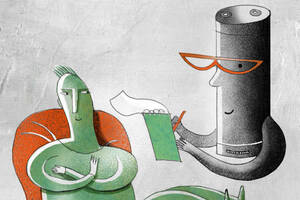Marketing Data Analytics Strategy May 5, 2014
The Customers You Do Not Want
If these “harbingers of failure” love what you do, you are in trouble

Yevgenia Nayberg
Bringing a new product to market is an expensive prospect: there are research and production costs to bear, as well as substantial opportunity costs if the product ends up flopping. Needless to say, firms want all of the information they can get from potential customers before a product ever makes it to the shelf.
Most market research efforts, says Eric Anderson, a professor of marketing at the Kellogg School of Management, focus on customers’ interactions with a product: Do they enjoy it? Which features do they like, and which do they dislike? But it is also important to pay attention to who these customers are. Feedback from lead users—often professionals or enthusiasts with extreme needs and special insights—has been shown to result in products that other customers enjoy more and that bring in more revenue.
“It’s easier to find out whether your product is going to fail than to find out whether your product is going to succeed.”
And a new study suggests that feedback from a very different, and unlikely, subset of customers could prove invaluable. Who? Anderson—who collaborated with colleagues Song Lin, Duncan Simester, and Catherine Tucker on the study—calls them “harbingers of failure.” Just as positive feedback from lead users signals that a new product will likely succeed, positive feedback from harbingers signals that a new product is likely to fail.
A Bad Omen
In the study, Anderson and his colleagues used data from a major retailer’s loyalty card program to examine the purchasing habits of nearly half a million customers over a two-year period. Specifically, the researchers were interested in purchases of new products: Which ones would still be on the shelves three years later, which would not, and who was buying the products that eventually failed?
“It’s important to remember: the products we’re looking at are ones that got very far through the pipeline,” says Anderson. “These are products where a manufacturer went out, they did concept testing, they talked to customers, they brought it to retailers, the retailers piloted it in their stores. The retailers said yes, it’s a product we want to roll out to our entire chain—and then it doesn’t last very long.”
Despite this lengthy process, the researchers found that just 40 percent of new products are still in stores three years later, a number in line with previous estimates. But critically, a product’s chances of succeeding depend not only on how much is sold but also on who is buying. The surprising finding is that when sales increase to a segment of consumers whom the authors label “harbingers of failure,” then the new product is more likely to fail. This finding contradicts nearly every metric of new-product success: How can more sales signal that your product is about to fail?
But sure enough, there is a very real class of customers who are uncannily attracted to products that will never catch on. Take, for instance, Diet Crystal Pepsi, a notorious product failure. Customers who purchase a product like this are also more likely to purchase, for instance, Frito Lay Lemonade, another product that eventually failed.
The worst of the harbingers? Repeat customers, those with a tendency to purchase a product like Diet Crystal Pepsi not just once, but over and over again. These customers really, really like the products that end up failing. Harbingers with a history of making four or more repeat purchases of a failed product are nearly twice as likely as other customers to buy another product that fails.
Customers With Niche Tastes
So what’s going on? Who are these harbingers who doom a product to a short shelf life? These customers do not seem to be shopping at odd hours, and they are not any more likely to pay full price for the products, both of which might indicate that they are less alert or savvy than other customers.
Instead, harbingers probably just have very unique tastes. “What seems to be happening is these customers have preferences that might be nonmainstream, or as we like to put it, they’re not representative of the overall population,” says Anderson. “We know when they really like your product, it shows that your product really appeals to a narrow group of customers.” Indeed, the researchers find that even among products that have not failed, harbingers are far more likely to purchase items that few others purchase. Firms that consistently tap into a segment of customers with niche preferences during every stage of market research, says, Anderson, are consistently going to fail.
Harbingers’ participation in market research studies might explain why so many failed products make it to stores in the first place. “You see this happening over and over again where managers or product developers think that their product is great because they can find customers who love it,” says Anderson. He continues: “Customers were able to raise their hand early in the process and say, this is a fantastic beer or this is a fantastic shampoo; whatever the product was, customers came back and said they loved it. But then we asked, well what kind of customers said they love it?”
Sure, other customers might give a new product a shot—and indeed, initial sales for failed products are often reasonably strong. (Failed products tend to “underperform the winners,” says Anderson, “but they aren’t terrible.”) Eventually, though, the customer base dwindles until just the small group of customers with niche tastes remains. “And that’s not enough to sustain the product in the long run,” says Anderson.
Know Thy Harbingers
The study suggests some rather simple approaches market researchers can take to weed out niche products before they ever appear in stores. Most obviously, firms should ask customers not just whether they would purchase the product in question, but what other products they regularly purchase. A customer who regularly purchases Swiffer mops, for instance, probably has fairly mainstream tastes and should be paid attention to.
But the customer still pining after that unusually flavored beer that was only in stores for three weeks? Market researchers should definitely pay attention to them. “It’s easier to find out whether your product is going to fail than to find out whether your product is going to succeed,” says Anderson. Confirmatory evidence is hard to come by: “if somebody really likes Swiffer mops, it doesn’t really tell you that if they like your product, you’re going to have a winner.” But if the biggest fan of your newest widget fell hard for that flavored beer, “you may not want to launch this product, because it’s probably not going to have the mainstream appeal that sustains products for the long run.”
Anderson, Eric, Song Lin, Duncan Simester, and Catherine Tucker. 2014. “Harbingers of Failure.” Working Paper.



